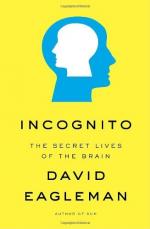
|
| Name: _________________________ | Period: ___________________ |
This test consists of 15 multiple choice questions and 5 short answer questions.
Multiple Choice Questions
1. What does Eagleman say has happened to complicated processes in his analogy of consciousness?
(a) They have been compressed from novels to short stores.
(b) They have been jumbled into split images.
(c) The processes have been compressed into headlines.
(d) They have been compressed to dots.
2. How do most people perform the motion on question number 62?
(a) They go counter-clockwise.
(b) They turn the wheel slightly to the right, then straighten it out again.
(c) They turn the wheel slightly to the left, then straighten it out again.
(d) They go clockwise.
3. To what does Eagleman compare consciousness?
(a) A video recorder.
(b) A newspaper.
(c) A camera.
(d) A kaleidoscope.
4. What are we actually unaware of?
(a) What is happening in real time.
(b) The small nuances.
(c) What is happening.
(d) Subtleties of change.
5. What does Eagleman say is the correct way to do this motion?
(a) Steer to the left, then straighten the wheel, then turn to the right.
(b) Move first clockwise, then counterclockwise.
(c) Use a reference point to scribe the circle.
(d) Steer to the right, then straighten the wheel, then turn to the left.
6. When an action becomes automatic, what part of the brain is controlling it?
(a) The unconscious mind.
(b) The conscious mind.
(c) It depends upon what the action entails.
(d) The superconscious mind.
7. How much of our brain is devoted to sight?
(a) 1/20.
(b) 1/10.
(c) 1/15.
(d) 1/3.
8. How do sorters learn to do their job?
(a) By an expert sorter correcting a novice.
(b) By watching experts sort.
(c) By studying videos of how to sort.
(d) By reading a how-to book.
9. How do hallways challenge May when he regains his sight?
(a) The apparent convergence of the walls in the distance confuses him.
(b) The way the floor and walls meet at angles is upsets his sense of balance.
(c) They are no challenge since he remembers how to interpret them from when he used to see.
(d) The feeling of confinement with the walls so close bothers him.
10. How does Alberts convince one African that the native's tongue is still intact?
(a) Having the man sing.
(b) Using a mirror.
(c) Pulling on the tongue in question.
(d) Having the man hold his tongue and try to talk.
11. What illustrations does Eagleman present to show the concept from question 44?
(a) Illustrations of how the eye can move too fast to be accurate.
(b) Illustrations of optical illusions.
(c) Illustrations of pictures within pictures.
(d) Illustrations of the eye structure.
12. What happens when one's brain changes?
(a) The person cannot change.
(b) The person is no longer functional.
(c) The person can become a genius.
(d) The person changes.
13. How is what a person likes determined?
(a) Largely by unconscious thinking.
(b) Largely by conscious thinking.
(c) By careful consideration of the conscious mind with input from the unconscious mind.
(d) There is no way to know that.
14. What does the amount of brain effort that vision uses indicate about vision?
(a) Vision is an extremely complex process.
(b) The brain is so capable, it doesn't take much of it for any sensory input.
(c) It can take place while easily freeing the brain for other matters.
(d) Vision is a very simple process of mirrors and reflections.
15. By what are thoughts underpinned?
(a) Sound.
(b) Electrical waves.
(c) Physical stuff.
(d) Fluids.
Short Answer Questions
1. What is meant by "implicit egotism"?
2. When do major league baseball players begin their swing while batting?
3. What indicates a state of sexual arousal in women?
4. What is the point of the exercise Eagleman has readers perform?
5. What does the author say lies underneath one's exterior looks?
|
This section contains 719 words (approx. 3 pages at 300 words per page) |

|




